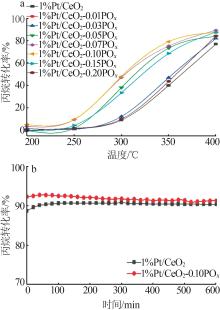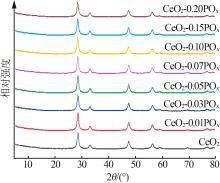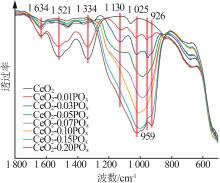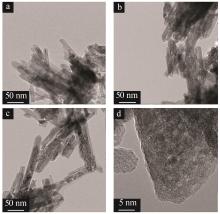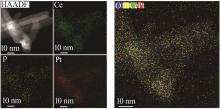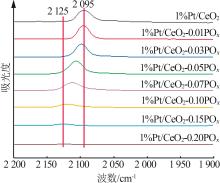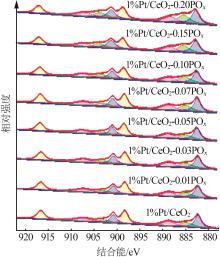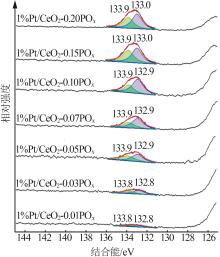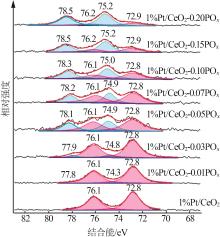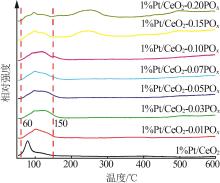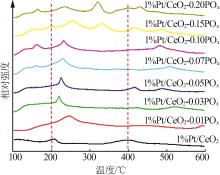Inorganic Chemicals Industry ›› 2024, Vol. 56 ›› Issue (1): 141-148.doi: 10.19964/j.issn.1006-4990.2023-0192
• Catalytic Materials • Previous Articles
Study on catalytic performance of phosphoric acid modified CeO2 nanorod supported Pt catalyst for propane combustion
JIN Shengshi1,2( ), LIU Kaijie2, LIU Qiuwen2, ZHANG Yibo1,2(
), LIU Kaijie2, LIU Qiuwen2, ZHANG Yibo1,2( ), YANG Xiangguang1,2(
), YANG Xiangguang1,2( )
)
- 1. School of Rare Earths,University of Science and Technology of China,Hefei 230026,China
2. Ganjiang Innovation Academy,Chinese Academy of Sciences,Ganzhou 341000,China
-
Received:2023-04-03Online:2024-01-10Published:2024-01-18 -
Contact:ZHANG Yibo, YANG Xiangguang E-mail:jss20@gia.cas.cn;yibozhang@gia.cas.cn;xgyang@gia.cas.cn
CLC Number:
Cite this article
JIN Shengshi, LIU Kaijie, LIU Qiuwen, ZHANG Yibo, YANG Xiangguang. Study on catalytic performance of phosphoric acid modified CeO2 nanorod supported Pt catalyst for propane combustion[J]. Inorganic Chemicals Industry, 2024, 56(1): 141-148.
share this article
Table 1
Pt dispersion and size of 1%Pt/CeO2 and1%Pt/CeO2-yPOx catalysts measured by CO pulse test"
| 催化剂 | CO滴定量/cm3 | n(Pt)/ mol | 分散度/ % | 铂粒径/nm |
|---|---|---|---|---|
| 1%Pt/CeO2 | 0.083 | 5.04×10-6 | 73.60 | 2.57 |
| 1%Pt/CeO2-0.01POx | 0.079 | 5.07×10-6 | 69.40 | 2.73 |
| 1%Pt/CeO2-0.03POx | 0.075 | 5.13×10-6 | 65.50 | 2.89 |
| 1%Pt/CeO2-0.05POx | 0.071 | 5.23×10-6 | 60.40 | 3.14 |
| 1%Pt/CeO2-0.07POx | 0.065 | 5.20×10-6 | 55.60 | 3.41 |
| 1%Pt/CeO2-0.10POx | 0.053 | 4.78×10-6 | 49.20 | 3.85 |
| 1%Pt/CeO2-0.15POx | 0.046 | 4.83×10-6 | 42.40 | 4.47 |
| 1%Pt/CeO2-0.20POx | 0.030 | 4.93×10-6 | 27.30 | 6.94 |
Table 2
Ratios of Ce3+ and Ce4+ on surface of 1%Pt/CeO2and 1%Pt/CeO2-yPOx catalysts"
| 催化剂 | 峰面积占比/% | |
|---|---|---|
| Ce3+ | Ce4+ | |
| 1%Pt/CeO2 | 23.11 | 76.89 |
| 1%Pt/CeO2-0.01POx | 19.80 | 80.20 |
| 1%Pt/CeO2-0.03POx | 20.18 | 79.82 |
| 1%Pt/CeO2-0.05POx | 19.23 | 80.77 |
| 1%Pt/CeO2-0.07POx | 21.40 | 78.60 |
| 1%Pt/CeO2-0.10POx | 23.78 | 76.22 |
| 1%Pt/CeO2-0.15POx | 24.71 | 75.29 |
| 1%Pt/CeO2-0.20POx | 25.90 | 74.10 |
| 1 | HE Chi, CHENG Jie, ZHANG Xin,et al.Recent advances in the catalytic oxidation of volatile organic compounds:A review based on pollutant sorts and sources[J].Chemical Reviews,2019,119(7):4471-4568. |
| 2 | YANG Xinwei, LI Qing, LU Erjun,et al.Taming the stability of Pd active phases through a compartmentalizing strategy toward nanostructured catalyst supports[J].Nature Communications,2019,10:1611. |
| 3 | XING Feilong, NAKAYA Y, YASUMURA S,et al.Ternary platinum-cobalt-indium nanoalloy on ceria as a highly efficient catalyst for the oxidative dehydrogenation of propane using CO2 [J].Nature Catalysis,2022,5(1):55-65. |
| 4 | LI Weijing, LI Tingyu, WEY M Y.Preferred enhancement of fast-SCR by Mn/CeSiOx catalyst:Study on Ce/Si promotion and shape dependence[J].Chemical Engineering Journal,2021,403:126317. |
| 5 | YOSHIDA H, YAZAWA Y, HATTORI T.Effects of support and additive on oxidation state and activity of Pt catalyst in propane combustion[J].Catalysis Today,2003,87(1/2/3/4):19-28. |
| 6 | BARAKAT T, ROOKE J C, TIDAHY H L,et al.Noble-metal-based catalysts supported on zeolites and macro-mesoporous metal oxide supports for the total oxidation of volatile organic compoun- ds[J].ChemSusChem,2011,4(10):1420-1430. |
| 7 | ZHANG Ling, PENG Yuexin, ZHANG Juan,et al.Adsorptive and catalytic properties in the removal of volatile organic compounds over zeolite-based materials[J].Chinese Journal of Catalysis,2016,37(6):800-809. |
| 8 | HU Zong, LIU Xiaofei, MENG Dongmei,et al.Effect of ceria crystal plane on the physicochemical and catalytic properties of Pd/ceria for CO and propane oxidation[J].ACS Catalysis,2016,6(4):2265-2279. |
| 9 | ZHU Liang, JIN Xin, ZHANG Yuyang,et al.Visualizing anisotropic oxygen diffusion in ceria under activated conditions[J].Physical Review Letters,2020,124(5):056002. |
| 10 | HAN Xinyu, LIU Kaijie, BIAN Mengyao,et al.CeO2–δ nanoparticles supported on SnNb2O6 nanosheets for selective catalytic reduction of NOx with NH3 [J].ACS Applied Nano Materials,2022,5(9):13529-13541. |
| 11 | HUANG Zhenpeng, CAO Shiying, YU Jihang,et al.Total oxidation of light alkane over phosphate-modified Pt/CeO2 catalys-ts[J].Environmental Science & Technology,2022,56(13):9661-9671. |
| 12 | MA Lei, SEO C Y, NAHATA M,et al.Shape dependence and sulfate promotion of CeO2 for selective catalytic reduction of NOx with NH3 [J].Applied Catalysis B:Environmental,2018,232:246-259. |
| 13 | CHEN Linxiao, AGRAWAL V, TAIT S L.Sulfate promotion of selective catalytic reduction of nitric oxide by ammonia on ceria[J].Catalysis Science & Technology,2019,9(8):1802-1815. |
| 14 | XIE Yu, WU Jinfang, JING Guojuan,et al.Structural origin of high catalytic activity for preferential CO oxidation over CuO/CeO2 nanocatalysts with different shapes[J].Applied Catalysis B:Environmental,2018,239:665-676. |
| 15 | TSUHAKO M, DANJO M, BABA Y,et al.Preparation and chemical properties of a novel layered cerium(Ⅳ) phosphate[J].Bulletin of the Chemical Society of Japan,1997,70(1):143-148. |
| 16 | DING Yilun, MIAO Dengyun, FENG Jingyao,et al.Enhanced formation of multi-branched isoparaffins in syngas conversion by ZnCrOx -MCM-22 composites[J].Applied Catalysis B:Environmental,2022,316:121628. |
| 17 | ZHANG Lunliang, HUANG Siyu, WENG Yao,et al.Preparation of Ni-P-Ti3C2Tx -Ce composite coating with enhanced wear resistance and electrochemical corrosion behavior on the surface of low manganese steel[J].Surface and Coatings Technology,2022,441:128508. |
| 18 | YANG Bin, ZENG Yiqing, ZHANG Mingjia,et al.Highly efficient K-doped Mn-Ce catalysts with strong K-Mn-Ce interaction for toluene oxidation[J].Journal of Rare Earths,2023,41(3):374-380. |
| 19 | POZDNYAKOVA O, TESCHNER D, WOOTSCH A,et al.Preferential CO oxidation in hydrogen(PROX) on ceria-supported catalysts,part I:Oxidation state and surface species on Pt/CeO2 under reaction conditions[J].Journal of Catalysis,2006,237(1):1-16. |
| 20 | 韩新宇,刘凯杰,边梦瑶,等.Ce-MnOx 低温净化氮氧化物和一氧化碳的催化性能研究[J].无机盐工业,2021,53(12):35-42. |
| HAN Xinyu, LIU Kaijie, BIAN Mengyao,et al.Catalytic performance study of Ce-MnOx for low-temperature purification of nitrogen oxides and carbon monoxide[J].Inorganic Chemicals Industry,2021,53(12):35-42. |
| [1] | DI Lu, WANG Weiguo, CHEN Juexian, WU Chuanshu. Study on preparation of transition metal-supported Silicalite-1 zeolite catalyst and its catalytic performance for furfural hydrogenation [J]. Inorganic Chemicals Industry, 2024, 56(4): 125-132. |
| [2] | TANG Bei. Preparation of ZnO/g-C3N4 heterojunction photocatalytic material and its degradation of pyridine [J]. Inorganic Chemicals Industry, 2024, 56(4): 133-142. |
| [3] | ZHU Jinjian, YANG Xiaxia, MU Zhanpeng, SONG Guoliang, LI Zihan, LIU Wei, XU Yan, ZHANG Jingcheng. Effect of different additives on liquid phase selective hydrogenation performance of maleic anhydride over Ni/Al2O3 [J]. Inorganic Chemicals Industry, 2024, 56(4): 143-150. |
| [4] | ZHOU Xuan, LI Mengrui, CHEN Yichen, FAN Huiqiang, WANG Bin, YUAN Gang. Research progress of nickel-based phosphide composites in improving of catalytic water electrolysis for hydrogen evolution performance [J]. Inorganic Chemicals Industry, 2024, 56(4): 8-15. |
| [5] | CHEN Xu, YANG Gang, LI Haitao. Study on preparation of multistage pore nano-SAPO-34 molecular sieves and its methanol to olefin performance [J]. Inorganic Chemicals Industry, 2024, 56(1): 134-140. |
| [6] | HU Mingliang, ZHOU Wei, LI Bin, LAI Xiaoling. Research progress of synergistic effect catalytic reforming of methane and carbon dioxide [J]. Inorganic Chemicals Industry, 2024, 56(1): 23-32. |
| [7] | WU Luming, YU Haibin, WANG Yaquan. Research progress of porous carbon-based non noble metal electrocatalysts for oxygen reduction [J]. Inorganic Chemicals Industry, 2023, 55(10): 13-23. |
| [8] | WANG Peng, ZHAO Shanshan, LU Yanfei, LI Shisong, WANG Chunlei, SHU Chang, ZHANG Dongsheng. Study on preparation of copper-based materials and its catalytic performance for hydrogenation of dimethyl succinate [J]. Inorganic Chemicals Industry, 2023, 55(10): 145-152. |
| [9] | LI Tong, YIN Hongfeng. Study on controllable preparation of nickel phyllosilicate nanotubes catalysts and their catalytic performance [J]. Inorganic Chemicals Industry, 2023, 55(5): 128-136. |
| [10] | ZHANG Yongkun, CHANG Yang, LI Xiaoguo, LIU Yan, XING Changxin, GAO Jinping, XIAO Jiawang, HOU Zhanggui. Study on modification of HZSM-5 catalyst and its pilot catalytic performance for alkylation of benzene with dilute ethylene [J]. Inorganic Chemicals Industry, 2023, 55(5): 137-142. |
| [11] | ZHAO Hongjuan, WANG Jiujiang, LIU Yuhang, LI Ning, CAO Gengzhen, LIU Honghai. Impact of heterogenous crystal seeds on synthesis of NaY zeolite [J]. Inorganic Chemicals Industry, 2023, 55(4): 120-124. |
| [12] | LI Liangrong, YANG Xiaozhe, CHEN Chuxin, LIU Yan, ZHANG Mengling, DING Yonghong. Research progress of photocatalytic water splitting of semiconductor core-shell materials for hydrogen production [J]. Inorganic Chemicals Industry, 2023, 55(3): 10-20. |
| [13] | SONG Wancang, ZANG Jiazhong, QIAO Bin, YUE Siyu, HONG Luwei, LI Chen. Study on epoxidation of 1-pentene catalyzed by TS-1 in fixed-bed reactor [J]. Inorganic Chemicals Industry, 2023, 55(3): 126-133. |
| [14] | LI Peng, YANG Siyuan, LUO Shizhong, DU Peining, TAN Renjun, JING Fangli. Neodymium-modified iron-based catalysts for nitrogen oxides removal [J]. Inorganic Chemicals Industry, 2023, 55(3): 140-146. |
| [15] | WEN Yuan, ZHOU Chenliang, ZHANG Qiang, YU Linfei, HE Wenxiu, LIU Quansheng. Research progress of electronic and structure promoters of iron-based catalysts for FTO reaction [J]. Inorganic Chemicals Industry, 2023, 55(3): 36-46. |
| Viewed | ||||||
|
Full text |
|
|||||
|
Abstract |
|
|||||
|
||
